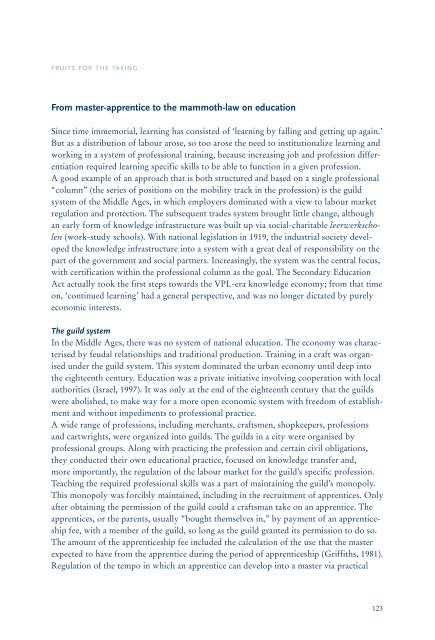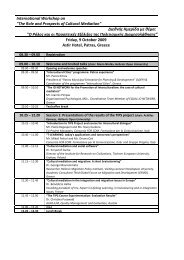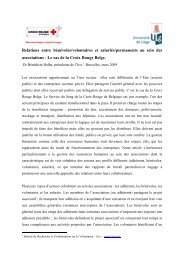Valuing Prior Learning
Valuing Prior Learning
Valuing Prior Learning
You also want an ePaper? Increase the reach of your titles
YUMPU automatically turns print PDFs into web optimized ePapers that Google loves.
Since time immemorial, learning has consisted of ‘learning by falling and getting up again.’<br />
But as a distribution of labour arose, so too arose the need to institutionalize learning and<br />
working in a system of professional training, because increasing job and profession differentiation<br />
required learning specific skills to be able to function in a given profession.<br />
A good example of an approach that is both structured and based on a single professional<br />
“column” (the series of positions on the mobility track in the profession) is the guild<br />
system of the Middle Ages, in which employers dominated with a view to labour market<br />
regulation and protection. The subsequent trades system brought little change, although<br />
an early form of knowledge infrastructure was built up via social-charitable leerwerkscholen<br />
(work-study schools). With national legislation in 1919, the industrial society developed<br />
the knowledge infrastructure into a system with a great deal of responsibility on the<br />
part of the government and social partners. Increasingly, the system was the central focus,<br />
with certification within the professional column as the goal. The Secondary Education<br />
Act actually took the first steps towards the VPL-era knowledge economy; from that time<br />
on, ‘continued learning’ had a general perspective, and was no longer dictated by purely<br />
economic interests.<br />
<br />
In the Middle Ages, there was no system of national education. The economy was characterised<br />
by feudal relationships and traditional production. Training in a craft was organised<br />
under the guild system. This system dominated the urban economy until deep into<br />
the eighteenth century. Education was a private initiative involving cooperation with local<br />
authorities (Israel, 1997). It was only at the end of the eighteenth century that the guilds<br />
were abolished, to make way for a more open economic system with freedom of establishment<br />
and without impediments to professional practice.<br />
A wide range of professions, including merchants, craftsmen, shopkeepers, professions<br />
and cartwrights, were organized into guilds. The guilds in a city were organised by<br />
professional groups. Along with practicing the profession and certain civil obligations,<br />
they conducted their own educational practice, focused on knowledge transfer and,<br />
more importantly, the regulation of the labour market for the guild’s specific profession.<br />
Teaching the required professional skills was a part of maintaining the guild’s monopoly.<br />
This monopoly was forcibly maintained, including in the recruitment of apprentices. Only<br />
after obtaining the permission of the guild could a craftsman take on an apprentice. The<br />
apprentices, or the parents, usually “bought themselves in,” by payment of an apprenticeship<br />
fee, with a member of the guild, so long as the guild granted its permission to do so.<br />
The amount of the apprenticeship fee included the calculation of the use that the master<br />
expected to have from the apprentice during the period of apprenticeship (Griffiths, 1981).<br />
Regulation of the tempo in which an apprentice can develop into a master via practical<br />
123




